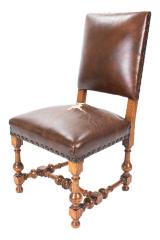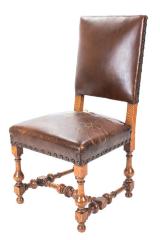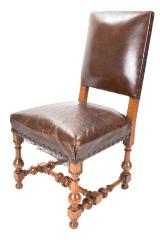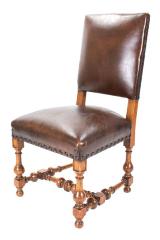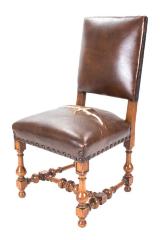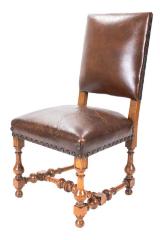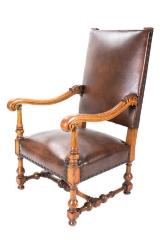Furniture ➔ Armchair
Identifier:
191480.2Description:
This armchair was manufactured by Retting Furniture Company between 1905 and 1920. It has a padded leather backrest and seat that are trimmed with brass tacks and the stiles, which are topped with grooved rectangular caps, extend to create the rear baluster-turned legs. The cyma-curved scrolled armrests feature foliate motifs near the stiles and are supported by balusters. The front legs are also baluster-turned and it has a turned H-stretcher.This chair is part of a pair that includes 191480.1. The Museum has another matching set from Retting Furniture Company that includes 192730, 192731, 192732, 192733, 192734, 185437, 201377, and 201378.
Marks and Labels
-"G477": Metal oval tag on the inside of the rear right leg
Date:
1905 – 1920Materials:
Oak, LeatherDimensions:
45" h 26" w 27" dCurrent Location Status:
In StorageCollection Tier:
Tier 2Source:
Gift of the Grand Rapids City HallRelated Entities:
Retting Furniture Company (creator)Alternate names: Retting and Sweet Furniture Company
Grand Rapids, Michigan.
Manufacturer of fine upholstered drawing room, lodge, and ecclesiastical furniture in period styles, including Louis XV and XVI, William and Mary, Queen Anne, Elizabethan, Jacobean, Chippendale, Hepplewhite, and Renaissance. Retting produced the furnishings for many of the lodge halls in Grand Rapids. Successor to Retting & Sweet. Located on Godfrey Ave. Executives listed in 1895 directory were Charles F. Retting (President), Walter S Brackett (Vice President), Robert A. Matheson (Secretary), Charles B. Retting (Treasurer).
SEE ALSO Retting & Sweet Grand Rapids City Hall (donor)
In the fall of 1969, many Grand Rapids citizens watched with horror and dismay as the wrecking ball completed its destruction of the old City Hall. Located at the corner of Lyon Street and Ottawa Avenue, the 1888 Romanesque Revival building was designed by Elijah E. Myers, architect of state capitols buildings in Michigan, Texas, and Colorado.
The struggle to save the old City Hall marked a turning point in the preservation movement in Grand Rapids. Many people felt that the loss of such an architectural treasure to the enveloping tide of urban renewal was a signal to begin a more thoughtful and balanced approach to urban growth.
The Grand Rapids Public Museum has several architectural elements from the old City Hall on exhibit including the encaustic floor tiles that filled the building, the clock mechanism that crowned its tower, and the allegorical figures of Night and Day that stood guard outside the front entrance.
